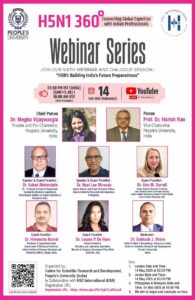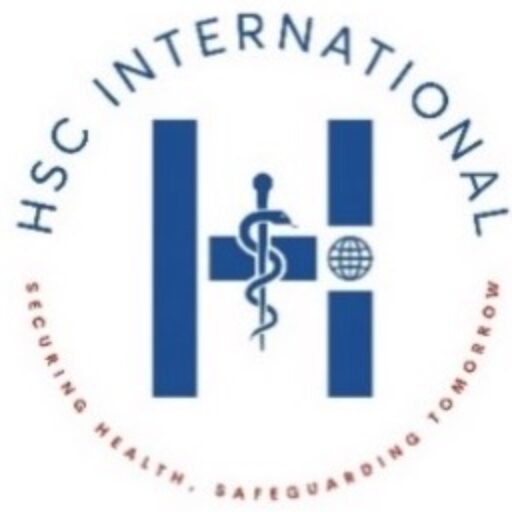Global Health Security at a Crossroads: Expert Panel Explores India’s Pandemic Preparedness Future
May 14, 2025

The future of global health security was under intense scrutiny as nearly 1,000 experts from 20 countries gathered for HSC International’s final H5N1 360° webinar session. What emerged was both a sobering assessment of emerging threats and an inspiring vision of how nations like India can lead the world toward more resilient pandemic preparedness.
H5N1: Building India’s Future Preparedness
The New Landscape of Health Security
The May 14th Global Health Dialogue Session marked a pivotal moment in pandemic preparedness discussions. Unlike traditional health security conversations focused on response capabilities, this gathering of international experts tackled the complex intersection of cutting-edge science, emerging technologies, and real-world implementation challenges.
“We stand at the intersection of emerging global health threats and rapid scientific advancement,” noted the session moderator, emphasizing the urgent need to unite cross-border knowledge with local innovation. The timing couldn’t be more critical—as H5N1 continues its global spread and new technologies reshape the biosecurity landscape.
India’s Bold Vision for Health Independence
Dr. Ashok Mehendale’s comprehensive overview of India’s strategic response revealed a country transforming from reactive crisis management to proactive health security leadership. The centerpiece of this transformation is ICMR’s ambitious initiative to develop indigenous H5N1 vaccines through partnerships with both public and private organizations.
But India’s approach extends far beyond vaccine development. The establishment of the National Institute of One Health (NIOH) in Nagpur, complete with BSL-3 and BSL-4 laboratories, represents a massive investment in research infrastructure. Combined with mandatory poultry farm registration and enhanced surveillance systems, India is building what Dr. Mehendale called “a unified, structured One Health platform.”
The scope is impressive: from the Indian Epidemic Intelligence Services conducting real-time monitoring to specialized institutes like the National Institute of High Security Animal Diseases serving as WHO reference laboratories. This infrastructure creates multiple layers of protection against zoonotic threats.
Rethinking Prevention: The Upstream Approach
Dr. Noel Miranda from the Philippines challenged participants to expand their thinking beyond traditional health sector responses. His concept of “upstream” prevention—addressing climate change, biodiversity loss, and ecosystem degradation—reframes pandemic preparedness as an environmental and sustainability challenge.
“Everything starts upstream,” Dr. Miranda emphasized, introducing the provocative concept of “infectious disease emergence footprints” that parallel climate change impacts. His vision of regional cooperation, where countries share resources and expertise through centers of excellence, offered a compelling alternative to isolated national responses.
This approach resonates particularly strongly in the context of H5N1, where migratory birds, climate change, and ecosystem disruption create the conditions for viral emergence and spread. Dr. Miranda’s call for “massive collaboration” across sectors reflects the complex, interconnected nature of modern health threats.
The Synthetic Biology Paradox
Perhaps the most riveting discussions centered on synthetic biology’s double-edged potential. Dr. Leyma De Haro delivered a masterful analysis of how the same technologies enabling rapid vaccine development and innovative therapeutics also create unprecedented biosecurity risks.
The statistics are sobering: gene synthesis machines that once cost millions and required years of training can now be operated by relative novices. AI tools are democratizing access to capabilities that could enhance pathogen virulence or transmissibility. “We’re looking at a horizon time of weeks to months, not years,” Dr. Harrow warned, referring to the pace of technological advancement.
Yet her message wasn’t one of technological pessimism. Instead, she advocated for sophisticated risk management approaches that preserve innovation while implementing appropriate safeguards. Her recommendations—from DNA synthesis screening to “secure by design” principles—offer practical pathways for managing dual-use risks.
The Cultural Challenge of Biosafety
Dr. Erin Sorel’s contributions highlighted a often-overlooked aspect of pandemic preparedness: the human factor. Her observations about integrating diverse expertise—AI specialists working alongside virologists, environmental scientists collaborating with public health officials—reflect the interdisciplinary nature of modern health security challenges.
“We need to educate new players on the landscape,” Dr. Sorel noted, emphasizing that traditional biological research communities must incorporate expertise from artificial intelligence, data science, and other fields that weren’t historically part of biodefense planning.
This integration challenge extends beyond technical collaboration to fundamental questions about governance, oversight, and international coordination. As Dr. Sorel observed, policies consistently lag behind technological innovation, creating gaps that require creative solutions.
Academic Innovation and Real-World Impact
Dr. Himanshu Kumar’s perspective as an academic leader provided crucial insights into how educational institutions can drive pandemic preparedness. His description of India’s institutional biosafety committees and international collaborative frameworks demonstrated how academic institutions serve as both training grounds and innovation hubs.
“Basic research is pivotal,” Dr. Kumar emphasized, noting that fundamental understanding of host-pathogen interactions drives development of vaccines, therapeutics, and diagnostics. His work with Nipah virus, conducted through international collaborations with French BSL-4 facilities and Indian institutions, exemplifies the kind of cross-border academic partnerships essential for addressing global health threats.
Integration: The Persistent Challenge
Throughout the nearly two-hour dialogue, a consistent theme emerged: the critical importance of integration across traditional boundaries. Whether discussing One Health approaches connecting human, animal, and environmental health, or international frameworks aligning global standards with local capabilities, success requires seamless coordination across multiple domains.
The panel identified several persistent challenges:
Funding Sustainability: All panelists emphasized that effective preparedness requires sustained financial commitment, not just crisis-driven funding spikes.
Regulatory Harmonization: Creating frameworks flexible enough to adapt to rapidly evolving technologies while maintaining appropriate oversight.
Public Trust: Building community confidence in scientific institutions and health authorities—a challenge highlighted by recent pandemic experiences.
Workforce Development: Training professionals who can work effectively across traditional disciplinary boundaries.
The Technology Integration Imperative
One of the session’s most compelling insights concerned the role of artificial intelligence and digital technologies in pandemic preparedness. Dr. De Haro discussed both the promise and peril of AI in biological research, while other panelists highlighted opportunities for AI-enhanced surveillance and early warning systems.
The conversation revealed a nuanced understanding that technology alone cannot solve pandemic preparedness challenges. Instead, successful integration requires careful attention to governance, ethics, and equity considerations. As Dr. Haro noted, “We want to make sure we all benefit from these technological advances, but we need to do it cautiously.”
Looking Forward: Sustained Commitment Required
As the webinar series concluded, participants faced a fundamental question: Can the global health community maintain the level of collaboration and innovation demonstrated during acute crisis periods?
The answer may depend on initiatives like HSC International’s webinar series, which create sustained platforms for knowledge exchange and relationship building. The 918 participants from 20 countries represent more than just an audience—they form a growing global network committed to advancing health security.
India’s emergence as a leader in this space is particularly significant. The country’s combination of technical capabilities, manufacturing capacity, and commitment to equitable access positions it to play a crucial role in global health security. However, realizing this potential requires continued investment in the collaborative approaches demonstrated throughout the H5N1 360° series.
The Path Ahead
The Global Health Dialogue Session didn’t just conclude a webinar series—it charted a course for future pandemic preparedness that balances innovation with security, global coordination with local adaptation, and scientific advancement with ethical responsibility.
The challenges are complex: managing dual-use technologies, building sustainable funding mechanisms, fostering international collaboration while respecting national sovereignty, and maintaining public trust in an era of increasing scientific complexity. But the solutions emerging from sessions like this offer genuine hope for more resilient global health systems.
As participants logged off from countries spanning multiple continents and time zones, they carried with them not just new knowledge but expanded networks of collaboration. In an interconnected world where health threats recognize no borders, these relationships may prove as valuable as any specific technical advancement.
The question now is whether this momentum can be sustained and translated into the kind of sustained action that effective pandemic preparedness requires. The stakes couldn’t be higher, and the opportunity for leadership has never been greater.
The Global Health Dialogue Session represented the culmination of HSC International’s H5N1 360° Webinar Series, a collaborative initiative with People’s University, Bhopal, that brought together global expertise to address critical health security challenges facing our interconnected world.

